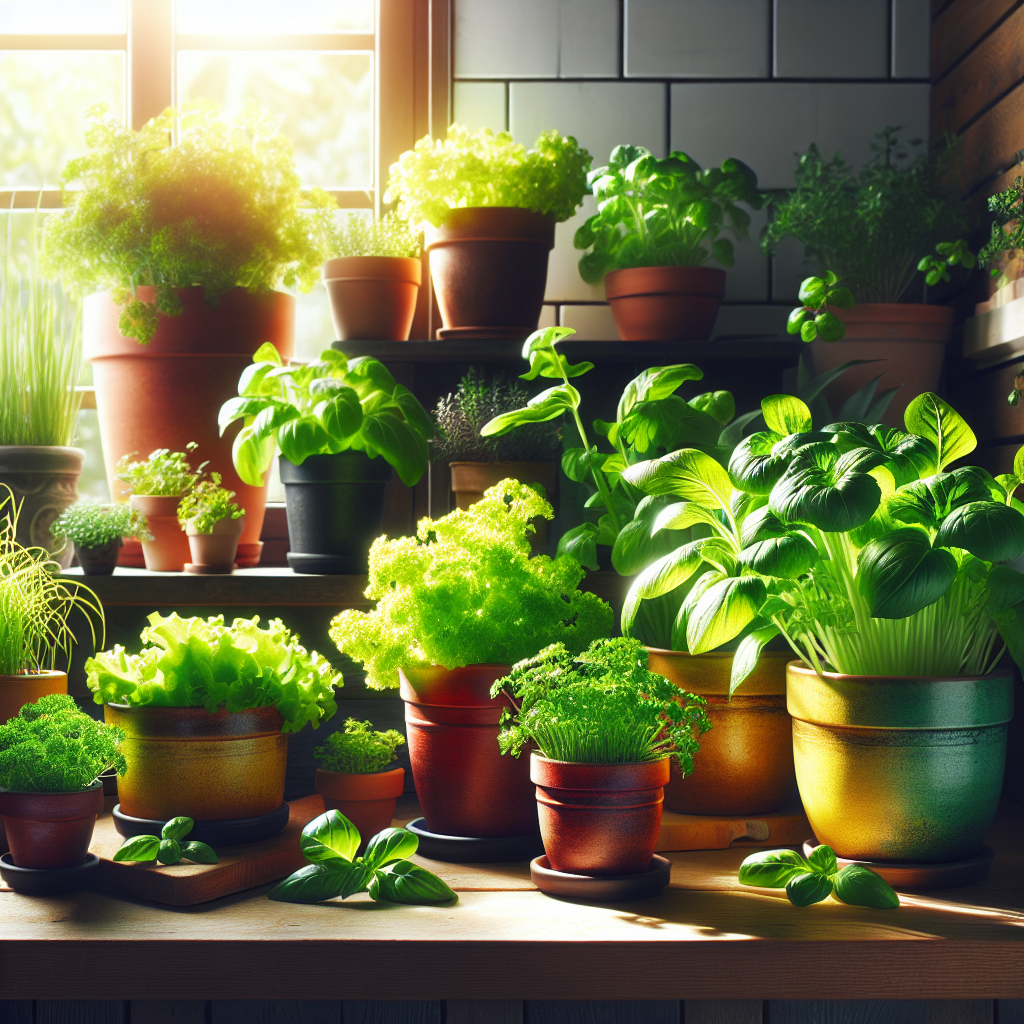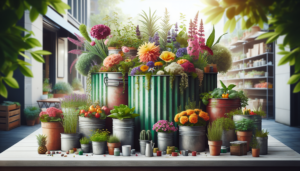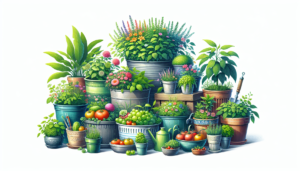
In this article, we will explore some exciting and innovative container gardening ideas specifically designed for your kitchen. Adding a touch of greenery to your cooking space not only enhances its aesthetic appeal but also provides you with fresh herbs and vegetables right at your fingertips. From vertical herb gardens to hanging baskets and windowsill planters, there are endless possibilities to transform your kitchen into a lush garden oasis. Get ready to bring nature indoors and elevate your culinary experience with these creative container gardening ideas!
Herb container garden
Growing herbs in containers is a convenient and rewarding way to bring freshness and flavor to your kitchen. Whether you have a spacious backyard or a cozy balcony, a herb container garden is a versatile option for any space.
Choosing the right herbs for your kitchen garden
When selecting herbs for your container garden, it’s essential to consider the herbs you frequently use in your cooking. Some popular options include basil, mint, parsley, rosemary, and thyme. These herbs not only add a burst of flavor to your dishes but also possess medicinal benefits. Choose herbs that thrive in your climate and are suitable for container gardening.
Selecting the perfect containers for herbs
Choosing the right containers is crucial for the success of your herb container garden. Opt for containers that have drainage holes to prevent waterlogged soil. Clay pots or wooden containers are excellent choices as they allow proper airflow and drainage. Make sure the containers are appropriately sized to accommodate the mature growth of your herbs.
Arranging your herb garden for optimal growth
When arranging your herb container garden, consider the growth habits of each herb. Place taller herbs like rosemary or basil at the back of the container or in the center if it’s a circular container. Surround them with smaller herbs like thyme or parsley. This arrangement ensures that each herb has access to sunlight and prevents overshadowing.
Maintaining and harvesting your herbs
To maintain your herb container garden, provide adequate sunlight, water, and nutrients. Most herbs require at least six hours of direct sunlight, so place your containers in a sunny spot. Water your herbs regularly, but avoid overwatering. Remember to harvest your herbs frequently to encourage new growth and enjoy the freshest flavors in your culinary creations.
Salad greens container garden
Growing your own salad greens in containers is a fantastic way to ensure a steady supply of fresh and nutritious greens throughout the year. Even if you have limited outdoor space, you can still enjoy a bountiful harvest of crispy, flavorful salad greens.
Picking the best varieties of salad greens for container gardening
Choose salad greens that are well-suited for container gardening, such as lettuce, spinach, arugula, and kale. Consider planting a variety of greens to add diversity to your salads. Opt for quick-growing varieties or cut-and-come-again types that allow continuous harvesting.
Selecting appropriate containers for salad greens
For salad greens, shallow containers with ample drainage are ideal. Consider using wide, shallow bowls or rectangular containers. These containers provide enough space for the roots to spread while allowing easy access for harvesting. Additionally, consider using self-watering containers to ensure consistent moisture levels.
Creating a space-efficient arrangement for your salad greens
When arranging your salad greens container garden, take advantage of the vertical space. Utilize tiered plant stands or hanging baskets to maximize your growing area. You can also interplant different varieties of salad greens in each container to create an attractive and functional display.
Providing proper care and watering for your salad greens
Salad greens require consistent watering to maintain crispness and flavor. Water your container garden frequently, keeping the soil evenly moist. Avoid wetting the leaves to prevent disease. Additionally, provide a good balance of sunlight and shade to ensure optimal growth. Harvest your salad greens when they reach the desired size for the freshest and most delicious salads.
Tomato container garden
Nothing beats the taste of homegrown tomatoes, and with a tomato container garden, you can enjoy these juicy fruits even without a traditional garden space. Growing tomatoes in containers allows you to control their environment, ensuring optimal growth and a bountiful harvest.
Choosing the ideal tomato varieties for container gardening
Select tomato varieties specifically bred for container gardening. Compact determinate varieties such as Cherry Tomatoes or Patio Tomatoes are excellent choices. Consider the size and growth habit of the tomato plants to determine the number of plants your containers can accommodate.
Selecting the right size and type of containers for tomatoes
Tomatoes have extensive root systems, so choose containers that are at least 18 inches deep and wide. Consider using fabric grow bags, plastic pots, or food-grade barrels for growing tomatoes. Ensure the containers have adequate drainage to prevent waterlogging.
Setting up optimal growing conditions for your tomato plants
Tomatoes thrive in full sun, so place your containers in a spot that receives at least six to eight hours of sunlight per day. Use well-draining soil mix enriched with compost and slow-release fertilizer to provide the necessary nutrients. Provide support for your tomato plants by using sturdy cages or trellises to prevent them from toppling over.
Pruning, staking, and other maintenance techniques for tomatoes
Pruning is essential for promoting airflow and preventing diseases. Regularly remove any suckers that grow in the leaf axils to encourage upward growth and fruit production. Consider staking or tying your tomato plants to support their weight as the fruits develop. Water your tomato plants consistently, ensuring the soil remains evenly moist. Harvest your ripe tomatoes when they are fully colored and slightly firm for the best taste.
Pepper container garden
Growing peppers in containers is a delightful way to add spice and heat to your culinary adventures. With the right care and selection of varieties, you can enjoy a bountiful harvest of vibrant and flavorful peppers.
Selecting the perfect pepper varieties for container gardening
Look for compact pepper varieties specifically bred for container gardening, such as Jalapeno, Pimiento, or Gypsy peppers. Consider the level of heat, flavor profile, and color preference when choosing your pepper plants. Opt for disease-resistant varieties to ensure healthy plants.
Choosing the appropriate containers for peppers
Select containers that are at least 12 inches in diameter to provide enough room for pepper plants to grow and develop roots. Clay or plastic containers with drainage holes are suitable options. Ensure the containers are placed in a sunny spot that receives at least six to eight hours of sunlight daily.
Providing the right growing conditions for your pepper plants
Peppers thrive in warm temperatures, so maintaining a consistent temperature between 70-85°F (21-29°C) is crucial. Use well-draining potting soil amended with compost for optimal growth. Water your pepper plants regularly, aiming for consistent soil moisture. Avoid overwatering, as it can lead to root rot and other problems.
Effective pest management for pepper container gardens
Monitor your pepper plants regularly for signs of pests such as aphids, spider mites, or pepper weevils. You can encourage beneficial insects like ladybugs or lacewings to control pest populations naturally. Consider using insecticidal soap or organic sprays to manage pests if necessary. Practice good garden hygiene by removing any fallen leaves or fruits promptly to prevent disease spread.
Microgreen container garden
Adding microgreens to your kitchen garden repertoire not only enhances your culinary creations but also provides a nutrient-packed addition to your meals. With a microgreen container garden, you can enjoy these miniature greens right at your fingertips.
Understanding the benefits of growing microgreens in your kitchen
Microgreens are young, tender greens harvested at the seedling stage. They are densely packed with essential nutrients and offer a concentrated burst of flavor. Growing microgreens in containers allows for easy access to fresh greens, regardless of the season or space constraints.
Finding suitable containers for microgreen cultivation
For growing microgreens, shallow containers with good drainage are ideal. Consider using seed trays, shallow plastic containers, or wooden boxes. Even recycled household items like shallow food trays can be repurposed for microgreen cultivation.
Creating a proper growing medium for your microgreens
Use a well-draining growing medium for your microgreens, such as seed-starting mix or coconut coir. Fill your containers with the growing medium, ensuring it is evenly spread. Moisten the growing medium before sowing the seeds to provide optimal conditions for germination.
Harvesting and using microgreens in your culinary creations
Microgreens are ready for harvest when they have developed their first true leaves, usually 1-3 weeks after sowing. Use a pair of clean scissors to cut the microgreens just above the soil level. Rinse them gently and use them fresh in salads, sandwiches, or as a garnish. Harvest only the amount you need to ensure continuous growth and a fresh supply of microgreens.
Mushroom container garden
Imagine having a steady supply of homegrown mushrooms to add an earthy and unique flavor to your culinary repertoire. With a mushroom container garden, you can explore the fascinating world of mushroom cultivation right in your own home.
Exploring the possibilities of growing mushrooms indoors
Growing mushrooms indoors is a rewarding endeavor that allows you to cultivate various types of delicious fungi. Mushrooms can be grown in containers, creating a mini mushroom habitat within your home. It’s an excellent way to learn about the different growing requirements of various mushroom species.
Choosing the right type of mushrooms for container gardening
Several mushroom species are suitable for container gardening, including oyster mushrooms, shiitake mushrooms, and button mushrooms. Each variety has its own growth requirements and flavor profile, so consider your preferences and availability of mushroom spawn when making your selection.
Setting up a suitable environment for indoor mushroom cultivation
Mushrooms require a specific environment to grow successfully. They thrive in dark, cool, and humid conditions. Create a growing area by placing your mushroom containers in a cool and dark location, such as a basement or closet. Provide consistent temperature and humidity levels by using a humidifier or misting the area regularly.
Harvesting and cooking homegrown mushrooms
Harvest your mushrooms when they reach the desired size and maturity. Different mushroom varieties have specific harvesting techniques, so research the best practices for your chosen species. Once harvested, mushrooms can be used in a variety of dishes, from stir-fries and soups to sauces and omelets. Enjoy the unique flavors and textures that homegrown mushrooms bring to your culinary creations.
Citrus container garden
The tangy aroma and juicy sweetness of citrus fruits can be yours to savor with a citrus container garden. Regardless of where you live, you can enjoy the beauty and bounty of citrus trees right in your own home.
Selecting the appropriate citrus fruits for container gardening
When choosing citrus trees for container gardening, consider dwarf or compact varieties that are well-suited for smaller spaces. Lemon, lime, mandarin, or kumquat varieties are excellent choices. Ensure the citrus trees you select are well-adapted to your climate.
Choosing the right containers for citrus trees
Citrus trees have deep root systems, so it’s crucial to select large, sturdy containers for their growth. Opt for pots made of clay or plastic that have sufficient drainage holes. Ensure the containers are at least 18-24 inches deep and wide to accommodate the root system and provide stability.
Providing the optimal growing conditions for healthy citrus plants
Citrus trees thrive in full sun, so place your containers in a sunny location that receives at least six to eight hours of direct sunlight daily. Use well-draining potting soil specifically formulated for citrus trees. Water your citrus plants regularly, keeping the soil consistently moist but not waterlogged. Fertilize your citrus trees with a slow-release citrus-specific fertilizer to provide the necessary nutrients.
Tips for successfully growing and harvesting citrus in containers
Pruning is essential for maintaining the shape and health of your citrus trees. Remove any dead or damaged branches and maintain a balanced shape. Ensure your citrus trees are protected from extreme cold or frost by moving them indoors during winter or providing adequate insulation. When your citrus fruits are fully ripe and have a vibrant color, gently harvest them by twisting the fruit until it detaches from the branch. Enjoy the sweet rewards of your nurturing efforts in refreshing citrus salads, desserts, or as a simple snack.
Salad herb container garden
Integrating fresh herbs into your salads is a fantastic way to elevate their flavors and add a burst of freshness to your dishes. With a salad herb container garden, you can have a constant supply of aromatic and flavorful herbs right on your kitchen countertop.
Choosing the best salad herbs to grow in containers
Consider growing a variety of salad herbs in your container garden to add a range of flavors to your salads. Popular choices include basil, cilantro, dill, mint, and parsley. Opt for herbs that are well-suited for container gardening and thrive in your climate. Experiment with different combinations to discover your favorite flavor profiles.
Matching the suitable containers for your salad herb garden
Herbs can be grown in individual containers or mixed together in larger containers. Ensure that each herb has sufficient space to grow and spread its roots. Use well-draining containers that allow excess water to escape. Consider using hanging baskets, clay pots, or herb-specific strawberry pots for a beautiful and practical herb garden display.
Positioning and organizing your salad herb garden effectively
Place your herb containers in a location that receives at least four to six hours of sunlight daily. If natural light is limited, consider using supplemental grow lights to provide the necessary light spectrum for optimal herb growth. Group herbs with similar growth requirements together to simplify care and watering.
Harvesting and utilizing flavorful salad herbs in your cooking
Harvest your salad herbs regularly, pinching off the young leaves from the top of each plant. Regular harvesting promotes bushier growth and ensures a continuous supply of fresh herbs. Rinse the harvested herbs and use them immediately in your salads. Freshly chopped herbs also make delightful additions to dressings, marinades, and sauces, enhancing the overall flavor profile of your culinary creations.
Bean and pea container garden
Growing beans and peas in containers is a fantastic way to enjoy the bountiful harvest of these legumes, even if you have limited garden space. With the right selection of varieties and appropriate support structures, you can cultivate a thriving bean and pea container garden.
Selecting the right bean and pea varieties for container cultivation
Look for bush-type or compact varieties of beans and peas that are well-suited for container gardening. Snap beans, bush beans, or dwarf pea varieties are excellent choices. Consider the flavor profile, cooking time, and preferred use of these legumes when making your selection.
Choosing the ideal containers and supports for climbing plants
Beans and peas require containers with adequate depth for their root systems. Choose pots that are at least 12 inches deep and wide. For climbing varieties, provide suitable supports such as trellises, stakes, or mesh netting. Ensure the support structures are secure and can accommodate the legume’s growth upward.
Creating a conducive environment for your bean and pea container garden
Beans and peas thrive in full sun, so place your containers in a location that receives at least six to eight hours of direct sunlight daily. Use well-draining potting soil amended with compost or organic matter to provide optimal growing conditions. Water your plants consistently, aiming for evenly moist soil. Mulch the containers to help retain moisture and control weed growth.
Tips for maximizing yield and managing pests in your legume garden
Encourage pollination in your bean and pea plants by gently shaking or tapping the flowers to release their pollen. This ensures proper fruit set and higher yield. Monitor your plants regularly for pests such as aphids, bean beetles, or caterpillars. Use organic pest control methods like handpicking or neem oil to manage pest populations. Harvest your beans and peas when they reach the desired size and tenderness for the freshest and most flavorful legumes.
Edible flower container garden
Adding a splash of color and a touch of elegance to your dishes is as easy as growing an edible flower container garden. Edible flowers not only enhance the visual appeal of your culinary creations but also offer unique flavors and fragrances that elevate your dining experience.
Discovering the beauty and taste of edible flowers
Edible flowers are a delightful addition to your container garden. They offer a range of colors, shapes, and flavors that can be used to enhance salads, desserts, cocktails, and more. Popular edible flowers include nasturtiums, marigolds, pansies, and violets. Ensure that the flowers you choose are safe for consumption and have not been treated with any chemicals.
Identifying suitable containers for growing edible flowers
For growing edible flowers, select containers that provide adequate space for each plant. Consider using shallow containers or hanging baskets for trailing varieties. Ensure the containers have proper drainage to prevent waterlogging. Additionally, use containers that complement the beauty of your flowers, adding an extra touch of visual appeal to your garden.
Providing proper care, light, and water for your edible flower garden
Edible flowers thrive in full sun, so place your containers in a sunny spot that receives at least six hours of direct sunlight daily. Use well-draining potting soil amended with compost for optimal growth. Water your edible flowers regularly, ensuring consistent soil moisture. Avoid oversaturating the soil, as it can lead to root rot.
Using edible flowers to enhance the visual appeal of your dishes
Harvest your edible flowers when they are fully open and vibrant in color. Gently pluck the flowers from the plants, removing any green parts or sepals. Rinse the flowers gently and use them as decorative elements in salads, desserts, drinks, or as a garnish. Experiment with different combinations of edible flowers to add a burst of color and an enticing aroma to your culinary creations.







